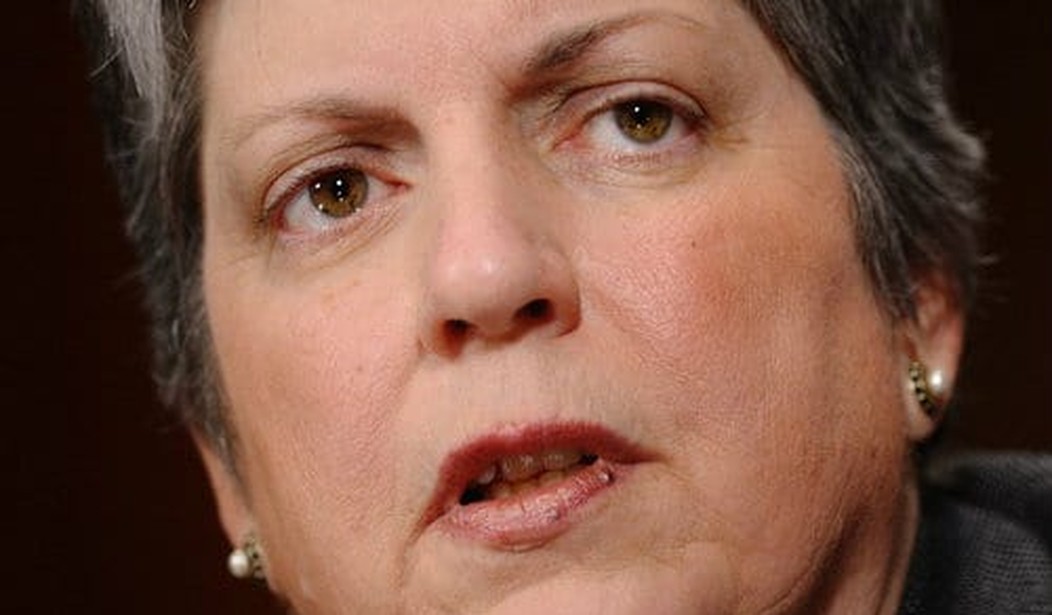Former Homeland Security Secretary Janet Napolitano said “operational control” of the U.S.-Mexico border is “unattainable.”
Napolitano also said the possibility of a terrorist crossing the border is “highly exaggerated.”
During a Council on Foreign Relations event, Napolitano was asked what it would take to secure the border.
“Operational control is a D.C. buzzphrase that’s used to totally keep moving the goalpost about the predicate needed on the Southern border so you can have immigration reform. The plain fact—and I’ve worked that border my whole professional life, almost, as I’ve been quoted saying. I’ve walked it. I’ve flown in helicopters. I’ve ridden a lot of it on horseback,” Napolitano said at the event as part of the HBO History Makers series.
“This is a multi-thousand-mile border. Some of it’s mountainous, some of it’s river, some of it’s absolute desert. You cannot seal this border and what operational control, in my view, is coming to mean in the Congress by some is ‘seal the border’. It’s a border. People go back and forth. They have since the two countries were developed, and before,” she added.
Rep. Michael McCaul (R-Texas) has introduced the Secure Our Borders First Act of 2015, which calls for the secretary of Homeland Security to gain and maintain operational control of the international borders of the U.S.
In the last session of Congress, McCaul introduced the Border Security Results Act of 2013, which defined operational control as “a 90 percent probability that illegal border crossers are apprehended and narcotics and other contraband are seized in high traffic areas.”
The former Arizona governor called the phrase “operational control,” used by some members of Congress, “a politically attractive” and “absolutely unattainable standard.”
“That’s not the right standard. The standard should be, is this as safe and secure a border as we can make it? And are we doing and undertaking those activities?” she said.
Napolitano downplayed the possibility of a terrorist crossing the border into the U.S. from Mexico.
“What you want to have is the greatest possible observation at the border. You want to have backup at the border. You remember, I mentioned on the international aviation side, moving the borders out? We need to do the same in the United States so that if someone gets through the physical border, there are—there are different places along the way where we have the greatest opportunity to find them,” she said.
“The variety of people crossing the border is—you have people coming to work, coming to reunite with their families, coming to bring their children to the greater land of opportunity. You have drug cartels and money launderers and you always have a suspicion that somebody’s actually coming in through Mexico to commit a terrorist act, although that is highly, highly, I think, exaggerated politically in Washington, D.C.,” she added.
In 2012, the Department of Justice shut down its National Drug Intelligence Center, which released annual National Drug Threat Assessments. That year, the National Drug Threat Assessment said Mexican drug cartels were operating in more than 1,000 U.S. cities. According to the report produced in 2011, Mexican-based trafficking organizations controlled access to the U.S.-Mexico border, the primary gateway for moving the bulk of illicit drugs into the U.S.
Napolitano told the audience the U.S. needs ports of entry that are big enough to handle the legal traffic coming back and forth with a reasonable amount of surveillance, similar to the security at airports.
A member of the audience asked Napolitano what she envisions for the size of the U.S. Border Patrol in the future, which currently has approximately 21,000 agents. For comparison, the New York City Police Department has 34,000 officers.
“You could literally, I guess, have a border patrol agent stationed every 100 miles along the U.S.-Mexican border, and so that border is 2,000, almost 3,000 miles long. Put that in your calculator and figure out what that would cost and what that would mean. Well, we’re not going to do that,” she said.
“So, really, when I mentioned it’s manpower and technology, the technology needs to be reinforced—reinforce the manpower. So you have sensors. You have air cover. We were able when I was secretary to finally establish air cover across that entire border,” she also said.
Napoliano criticized having a fence on the border: “I’m fond of saying, ‘Show me a ten-foot fence, and I’ll show you a twelve-foot ladder.’ That’s the way that works, but fencing can help dictate where traffic and flows are, and then where you put your backup.”









Join the conversation as a VIP Member